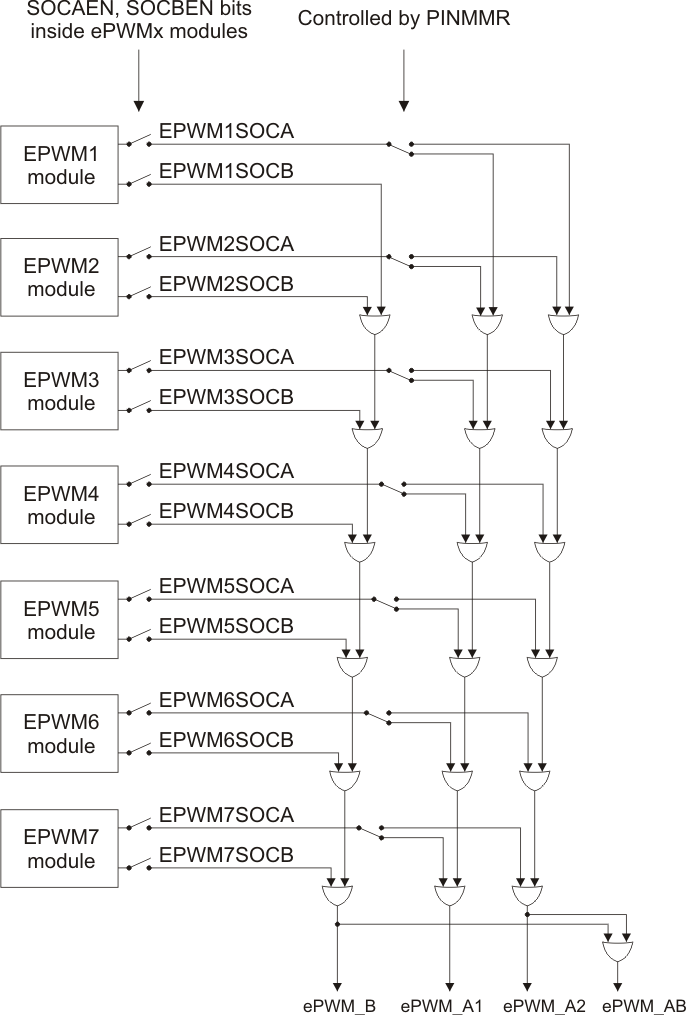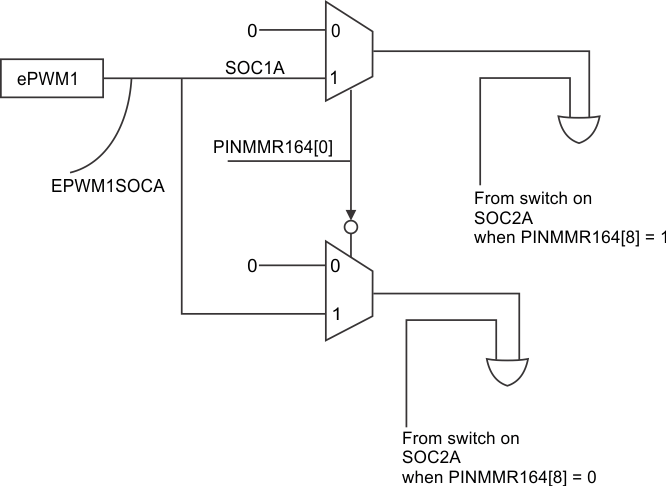SPNS254A June 2022 – March 2024 TMS570LC4357-SEP
PRODUCTION DATA
- 1
- 1 Features
- 2 Applications
- 3 Description
- 4 Device Comparison
-
5 Terminal Configuration and Functions
- 5.1 GWT BGA Package Ball-Map (337 Terminal Grid Array)
- 5.2
Terminal Functions
- 5.2.1
GWT Package
- 5.2.1.1 Multibuffered Analog-to-Digital Converters (MibADC)
- 5.2.1.2 Enhanced High-End Timer Modules (N2HET)
- 5.2.1.3 RAM Trace Port (RTP)
- 5.2.1.4 Enhanced Capture Modules (eCAP)
- 5.2.1.5 Enhanced Quadrature Encoder Pulse Modules (eQEP)
- 5.2.1.6 Enhanced Pulse-Width Modulator Modules (ePWM)
- 5.2.1.7 Data Modification Module (DMM)
- 5.2.1.8 General-Purpose Input / Output (GIO)
- 5.2.1.9 FlexRay Interface Controller (FlexRay)
- 5.2.1.10 Controller Area Network Controllers (DCAN)
- 5.2.1.11 Local Interconnect Network Interface Module (LIN)
- 5.2.1.12 Standard Serial Communication Interface (SCI)
- 5.2.1.13 Inter-Integrated Circuit Interface Module (I2C)
- 5.2.1.14 Multibuffered Serial Peripheral Interface Modules (MibSPI)
- 5.2.1.15 Ethernet Controller
- 5.2.1.16 External Memory Interface (EMIF)
- 5.2.1.17 Embedded Trace Macrocell Interface for Cortex-R5F (ETM-R5)
- 5.2.1.18 System Module Interface
- 5.2.1.19 Clock Inputs and Outputs
- 5.2.1.20 Test and Debug Modules Interface
- 5.2.1.21 Flash Supply and Test Pads
- 5.2.1.22 Supply for Core Logic: 1.2-V Nominal
- 5.2.1.23 Supply for I/O Cells: 3.3-V Nominal
- 5.2.1.24 Ground Reference for All Supplies Except VCCAD
- 5.2.1.25 Other Supplies
- 5.2.2 Multiplexing
- 5.2.1
GWT Package
-
6 Specifications
- 6.1 Absolute Maximum Ratings
- 6.2 ESD Ratings
- 6.3 Power-On Hours (POH)
- 6.4 Recommended Operating Conditions
- 6.5 Switching Characteristics Over Recommended Operating Conditions for Clock Domains
- 6.6 Wait States Required - L2 Memories
- 6.7 Power Consumption Summary
- 6.8 Input/Output Electrical Characteristics Over Recommended Operating Conditions
- 6.9 Thermal Resistance Characteristics for the BGA Package (GWT)
- 6.10 Timing and Switching Characteristics
-
7 System Information and Electrical Specifications
- 7.1 Device Power Domains
- 7.2 Voltage Monitor Characteristics
- 7.3 Power Sequencing and Power-On Reset
- 7.4 Warm Reset (nRST)
- 7.5 Arm Cortex-R5F CPU Information
- 7.6 Clocks
- 7.7 Clock Monitoring
- 7.8 Glitch Filters
- 7.9 Device Memory Map
- 7.10 Flash Memory
- 7.11 L2RAMW (Level 2 RAM Interface Module)
- 7.12 ECC / Parity Protection for Accesses to Peripheral RAMs
- 7.13 On-Chip SRAM Initialization and Testing
- 7.14 External Memory Interface (EMIF)
- 7.15 Vectored Interrupt Manager
- 7.16 ECC Error Event Monitoring and Profiling
- 7.17 DMA Controller
- 7.18 Real-Time Interrupt Module
- 7.19 Error Signaling Module
- 7.20 Reset / Abort / Error Sources
- 7.21 Digital Windowed Watchdog
- 7.22
Debug Subsystem
- 7.22.1 Block Diagram
- 7.22.2 Debug Components Memory Map
- 7.22.3 Embedded Cross Trigger
- 7.22.4 JTAG Identification Code
- 7.22.5 Debug ROM
- 7.22.6 JTAG Scan Interface Timings
- 7.22.7 Advanced JTAG Security Module
- 7.22.8 Embedded Trace Macrocell (ETM-R5)
- 7.22.9 RAM Trace Port (RTP)
- 7.22.10 Data Modification Module (DMM)
- 7.22.11 Boundary Scan Chain
-
8 Peripheral Information and Electrical Specifications
- 8.1
Enhanced Translator PWM Modules (ePWM)
- 8.1.1 ePWM Clocking and Reset
- 8.1.2 Synchronization of ePWMx Time-Base Counters
- 8.1.3 Synchronizing all ePWM Modules to the N2HET1 Module Time Base
- 8.1.4 Phase-Locking the Time-Base Clocks of Multiple ePWM Modules
- 8.1.5 ePWM Synchronization with External Devices
- 8.1.6 ePWM Trip Zones
- 8.1.7 Triggering of ADC Start of Conversion Using ePWMx SOCA and SOCB Outputs
- 8.1.8 Enhanced Translator-Pulse Width Modulator (ePWMx) Electrical Data/Timing
- 8.2 Enhanced Capture Modules (eCAP)
- 8.3 Enhanced Quadrature Encoder (eQEP)
- 8.4 12-bit Multibuffered Analog-to-Digital Converter (MibADC)
- 8.5 General-Purpose Input/Output
- 8.6 Enhanced High-End Timer (N2HET)
- 8.7 FlexRay Interface
- 8.8 Controller Area Network (DCAN)
- 8.9 Local Interconnect Network Interface (LIN)
- 8.10 Serial Communication Interface (SCI)
- 8.11 Inter-Integrated Circuit (I2C)
- 8.12 Multibuffered / Standard Serial Peripheral Interface
- 8.13 Ethernet Media Access Controller
- 8.1
Enhanced Translator PWM Modules (ePWM)
- 9 Applications, Implementation, and Layout
- 10Device and Documentation Support
- 11Revision History
- 12Mechanical, Packaging, and Orderable Information
Refer to the PDF data sheet for device specific package drawings
8.4.2.3 Controlling ADC1 and ADC2 Event Trigger Options Using SOC Output from ePWM Modules
As shown in Figure 8-9, the ePWMxSOCA and ePWMxSOCB outputs from each ePWM module are used to generate four signals – ePWM_B, ePWM_A1, ePWM_A2, and ePWM_AB, that are available to trigger the ADC based on the application requirement.
 Figure 8-9 ADC
Trigger Source Generation from ePWMx
Figure 8-9 ADC
Trigger Source Generation from ePWMx| CONTROL BIT | SOC OUTPUT |
|---|---|
| PINMMR164[0] | SOC1A_SEL |
| PINMMR164[8] | SOC2A_SEL |
| PINMMR164[16] | SOC3A_SEL |
| PINMMR164[24] | SOC4A_SEL |
| PINMMR165[0] | SOC5A_SEL |
| PINMMR165[8] | SOC6A_SEL |
| PINMMR165[16] | SOC7A_SEL |
The SOCA output from each ePWM module is connected to a "switch" shown in Figure 8-9. This switch is implemented by using the control registers in the PINMMR module. Figure 8-10 is an example of the implementation is shown for the switch on SOC1A. The switches on the other SOCA signals are implemented in the same way.
 Figure 8-10 ePWM1SOC1A Switch Implementation
Figure 8-10 ePWM1SOC1A Switch ImplementationThe logic equations for the four outputs from the combinational logic shown in Figure 8-9 are:
| ePWM_B = | SOC1B or SOC2B or SOC3B or SOC4B or SOC5B or SOC6B or SOC7B | (1) |
| ePWM_A1 = | [ SOC1A and not(SOC1A_SEL) ] or [ SOC2A and not(SOC2A_SEL) ] or [ SOC3A and not(SOC3A_SEL) ] or | (2) |
| [ SOC4A and not(SOC4A_SEL) ] or [ SOC5A and not(SOC5A_SEL) ] or [ SOC6A and not(SOC6A_SEL) ] or | ||
| [ SOC7A and not(SOC7A_SEL) ] | ||
| ePWM_A2 = | [ SOC1A and SOC1A_SEL ] or [ SOC2A and SOC2A_SEL ] or [ SOC3A and SOC3A_SEL ] or | (3) |
| [ SOC4A and SOC4A_SEL ] or [ SOC5A and SOC5A_SEL ] or [ SOC6A and SOC6A_SEL ] or | ||
| [ SOC7A and SOC7A_SEL ] | ||
| ePWM_AB = | ePWM_B or ePWM_A2 | (4) |